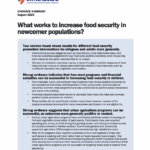In recent years, the concept of food desert has come to dominate research and policy debates around food environments and their impacts on health, with mounting evidence that low-income neighborhoods of color lack large supermarkets and therefore may have limited access to fresh, affordable, and healthy foods. We argue that this metaphor, which implies an absence of food, is misleading and potentially detrimental to the health of poor and racially diverse communities because it ignores the contribution of smaller stores, particularly that of so-called ethnic markets. Current applications of the food desert concept in this setting reflect classed and racialized understandings of the food environment that ignore the everyday geographies of food provision in immigrant communities while favoring external interventions. Our investigation of ethnic markets in City Heights, a low-income urban neighborhood in San Diego with a diverse immigrant population, offers evidence of their positive role in providing access to affordable, fresh, healthy, and culturally appropriate foods. Our results contribute to research by providing a nuanced description of the food environment beyond access to supermarkets, focusing specifically on immigrant neighborhoods, and pointing to ethnic markets as valuable partners in increasing food security in diverse urban areas.
A Systematic Review on the Impact of Trauma-Informed Education Programs on Academic and Academic-Related Functioning for Students Who Have Experienced Childhood Adversity
The purpose of this study was to conduct a systematic review of the existing literature regarding trauma-informed education programs and their impact on academic and academic-related outcomes. The articles included for review (n=15) contained data on trauma-informed education programs implemented in preschool, primary/elementary, and high school settings. Academic and academic-related outcomes reported included attendance, disciplinary…

